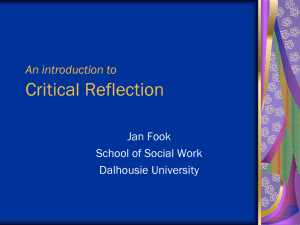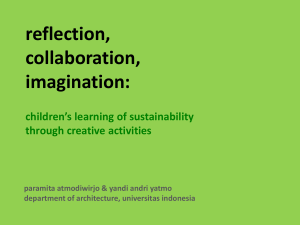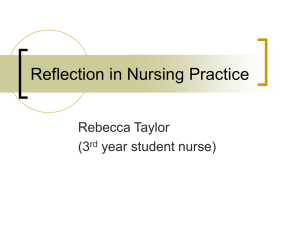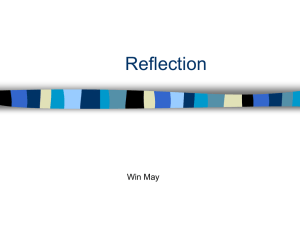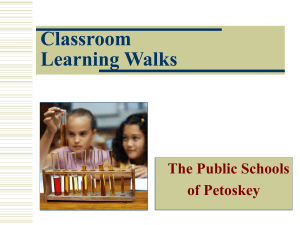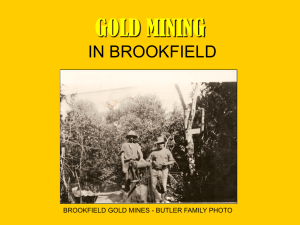Bryan, C. Critical reflection and challenging assumptions
advertisement
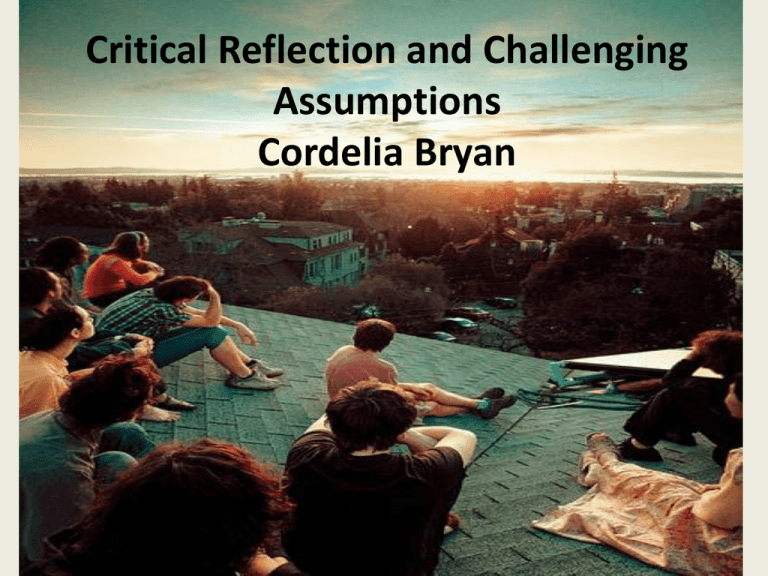
Critical Reflection and Challenging Assumptions Cordelia Bryan • Just thinking about or musing on things is a form of reflection • What is the difference between this and critical reflection? • Why is critical reflection what underpins this course? • How might I provide evidence of my own critical reflection? Challenging our assumptions Brookfield suggests that by hunting for our assumptions, we can begin a critical dialogue about what we do as teachers. Challenging our pedagogic assumptions is central to most accredited PG Cert.s and to CPD of teachers. Brookfield, S. (1995) Challenging our assumptions Paradigmatic assumptions are our renderings of ‘reality’ . It takes a considerable amount of contrary evidence and disconfirming experiences to change them. Brookfield, S. (1995) Challenging our assumptions Prescriptive assumptions are assumptions about what we think ought to be happening in a particular situation. How a ‘good’ teacher should behave What good educational processes ought to look like Challenging our assumptions Causal assumptions are usually stated in predictive terms. E.g. If we make mistakes in front of students this creates a trustful environment for learning in which students feel free to make errors with no fear of censure or embarrassment. Hunting Assumptions for your Reflective Statement It's common sense to visit small groups after you've set them a task, since this demonstrates your commitment to helping them learn. Visiting groups is an example of respectful, attentive, studentcentered teaching. Hunting Assumptions for your Reflective Journals Reflection Prompt • Think of some assumptions you held (or still hold) that have been challenged since engaging with pedagogic theory. • Write them down in your journal. Hunting Assumptions for your Reflective Journal Reflection Prompt Think of one assumption relating to teaching, learning or assessment you have examined and found to be ‘dodgy’. Identify whether it is • Paradigmatic • Prescriptive or • Causal What makes reflection critical? Brookfield argues that reflection becomes critical when it has two distinctive purposes: The first is to understand how considerations of power undergird, frame and distort so many educational processes and interactions. What makes reflection critical? The second is to question assumptions and practices that seem to make our teaching lives easier but that actually end up working against our own best long term interests - in other words, those that are hegemonic. Critical Reflection as the Illumination of Power The dynamics of power permeate all educational processes. Critical theory & reflection challenges the dominant beliefs & practices (Paulo Freire). Hunting and challenging our assumptions is often the first step in working more democratically and co-operatively with students and colleagues. Critical Reflection as the Recognition of Hegemonic Assumptions Hegemony describes the process whereby ideas, structures and actions come to be seen by the majority of people as wholly natural, preordained and working for their own good, when in fact they are constructed and transmitted by powerful minority interests to protect the status quo that serves these interests so well. Brookfield (1995) Challenging some potentially Hegemonic Assumptions Constructive alignment is common sense – why would one not align teaching with learning outcomes and their assessment? Developing Communities of Practice is based on learning as social participation. Is this not common sense & desirable? Communities of Practice Wenger, E. (2006) Theories of social structure: institutions; norms ; & rules Theories of social practice: groups; shared resources & mutual relationships Theories of identity: gender; class; ethnicity; age Theories of situated experience: daily existence; people & environments Theories of Collectivity Theories of meaning Theories of Power Theories of subjectivity Theories of Social Learning Challenging some potentially Hegemonic Assumptions Constructive alignment is common sense – why would one not align teaching with learning outcomes and their assessment? Developing Communities of Practice is based on learning as social participation. Is this not common sense & desirable? Communities of Practice Wenger, E. (2006) Reflection Prompt In each of the two statements on the previous slide there are inherent assumptions. What assumptions are inherent in the two learning theories? Make some notes in your Reflective Journal explaining them. Potential tensions for Critical Learning Communities In the next slide the two columns indicate some characteristics of Neo-liberal Higher Education set against characteristics of Critical Learning Communities. Reflective Prompt Consider whether the slide represents your experience of Higher Education. Write a few notes about your views and feelings before concluding with what you might DO to ‘square the circle’ so to speak. This is not a comfortable exercise! * Neo Liberal Higher Education Institutions Critical Learning Communities Individualism Community Focus on outcomes learning Focus on process of learning Efficiency Justice (Paulo Frere et al) Competition Cooperation Territoriality Teamwork Isolation/fragmentation Networking Defensive Responsive Closed working environment Open working environment References Brookfield, S. (1995) Becoming a critically reflective teacher. San Francisco: Jossey-Bass. Frere, P. (2001) Pedagogy of freedom: Ethics, democracy and civic courage. Oxford: Rowan and Littlefield * Laycock M. (2009) Developing Critical Learning Communities: a practical guide. Table showing the characteristics of Neo Liberal Higher Education Institutions and Critical Learning Communities presented at SEDA Conference: Underpinning Academic Practice with Research and Scholarship 7 & 8 May, 2009, Brighton, UK. Wenge, E. (2006) Communities of Practice: Learning Meaning and Identity, Cambridge University Press.

